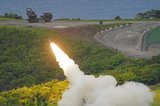GA-ASI completes key wind tunnel test on Sea Avenger UAS model
General Atomics Aeronautical Systems, Inc. (GA‑ASI), a leading manufacturer of unmanned aircraft systems (UAS), tactical reconnaissance radars, and sensor systems, today announced that it has successfully completed a key wind tunnel test on a model of its Sea Avenger UAS. Sea Avenger supports the Unmanned Carrier-Launched Airborne Surveillance and Strike (UCLASS) program by providing a long-endurance, survivable, carrier-based UAS for the US Navy.
The wind tunnel test validated the low-speed characteristics of a new wing, resulting in higher endurance and lower approach speeds. The new wing is also designed to increase aircraft dash speeds, decreasing the time to respond to potential threats.
"GA-ASI is committed to providing the Navy with swift delivery of a robust and versatile aircraft carrier-based UAS that meets or exceeds known requirements, provides measurable manpower savings, and assures best value," said Frank W. Pace, president, Aircraft Systems Group, General Atomics Aeronautical Systems, Inc. "Reducing risk is a key component of this process, and our company has repeatedly designed and delivered low-cost, high-quality UAS, in part, because of our recurring commitment to invest in early development, as evidenced by this recent wind tunnel test."
The 90-hour, eight-day test was conducted at the San Diego Air & Space Technology Center. The goal of the test, which was completed ahead of schedule, was to validate the low-speed characteristics of an updated wing in the approach, launch, and cruise configurations. The advanced design utilizes proprietary wing technology that enables high-speed flight, while also supporting excellent low-speed handling qualities desired for aircraft carrier landings.
The testing enabled GA-ASI to evaluate a specific set of configuration changes both quickly and economically. Wind tunnel testing also helps reduce program risk by providing empirical data to complement computational analyses. In addition, it provides the opportunity to correlate key performance data to analytical tools, such as computational fluid dynamics, and to validate various analytical methods.
Designed for fully autonomous launch and recovery from both USS Nimitz and USS Ford class carriers, Sea Avenger provides unmanned, autonomous, and long-endurance Intelligence, Surveillance, and Reconnaissance (ISR) capabilities responsive to the multi-mission requirements of carrier-based aircraft. The aircraft will provide for planning, control, tasking, collection, processing, analysis, and dissemination of actionable information in support of Navy missions. An evolution of the combat-proven Predator UAS series with high-performance maritime payloads, Sea Avenger provides the highest operational value while being the only affordable system capable of meeting the Navy's aggressive program schedule.
Source: GA-ASI
More from Uncrewed Vehicles
-
![What's next for the Pentagon after the Replicator programme?]()
What's next for the Pentagon after the Replicator programme?
Although the Replicator initiative has made several accomplishments, there are still multiple gaps to plug across the US Department of Defense (DoD) and its services.
-
![Cummings Aerospace showcases Hellhound loitering munition designed for US Army’s LASSO programme (video)]()
Cummings Aerospace showcases Hellhound loitering munition designed for US Army’s LASSO programme (video)
Cummings Aerospace presented its turbojet-powered Hellhound loitering munition at SOF Week 2025, offering a man-portable solution aligned with the US Army’s LASSO requirements.
-
![SOF Week 2025: PDW unveils attritable FPV drone for SOF operations at scale]()
SOF Week 2025: PDW unveils attritable FPV drone for SOF operations at scale
PDW has revealed its Attritable Multirotor First Person View drone at SOF Week 2025, offering special operations forces a low-cost, rapidly deployable platform for strike and ISR missions, inspired by battlefield lessons from Ukraine.
-
![SOF Week 2025: Teledyne FLIR white paper provides guidance on reusable loitering munitions]()
SOF Week 2025: Teledyne FLIR white paper provides guidance on reusable loitering munitions
Teledyne FLIR is highlighting the emerging requirements for 'recoverable and re-usable' loitering munitions across the contemporary operating environment during this week’s SOF Week conference in Tampa, Florida.
-
![SOF Week 2025: Kraken Technology group debuts K3 Scout USV in North America]()
SOF Week 2025: Kraken Technology group debuts K3 Scout USV in North America
High-performance maritime industry player Kraken Technology Group, based in the UK, has used the SOF Week conference in Tampa, Florida this week to debut its K3 Scout uncrewed surface vessel (USV) to the North American market.
-
![Palladyne AI and Red Cat to demonstrate capabilities for autonomous drone swarms to the US military]()
Palladyne AI and Red Cat to demonstrate capabilities for autonomous drone swarms to the US military
Red Cat and Palladyne AI recently conducted a cross-platform collaborative flight involving three diverse heterogeneous drones.

























